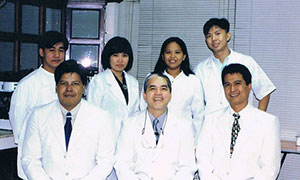The Clinic




How the clinic started
In the 70`s, the clinic was originally operating as a community out patient, medical and surgical unit. Most of the patients at that time were Filipino families wishing to migrate to Canada.
In House Diagnostic Facility
This made way for the birth of an in house diagnostic facility. Asymptomatic emigrants with excessive white blood cell (WBC) in their urinalysis were easily managed and therefore the process for immigration was faster.
Influx Of Prostatitis Patients
By the mid 70`s, patients with urinary and pelvic symptoms (UPS) began to come in because of the conveniences of a quick diagnosis followed by a more objective, monitored treatment.
Monitored Lab. Results and tri-weekly Prostate Drainage
In the 80`s Patient with UPS increased to more than 60 visitations per day. Soon after recruitment of more doctors also followed. This allowed plenty of room for learning. A training program was also realized. The monitored diagnosis allowed both senior and junior physicians to observe that the tri-weekly drainage with monitoring of WBC count from the prostate showed more predictive WBC readings as compared to patients that were drained less frequently. More patients were being cleared from Prostatitis. Cure was based on what the patents told us at the end of the treatment, through letters, and from patents referred to us by previous sufferers.
Transformation of a community clinic to a Genitourinary Clinic
In addition to the Pelvic symptoms, sexual dysfunction i.e., erectile, ejaculation and infertility were also corrected. The protocol was found to also to relieve symptoms of men in urinary retention. Previously enlarge prostates was also seen to decrease in size. Women both young and old were also being referred because of recurring urinary tract infections, or UTI. Patients from other countries and fellow physicians also began to come in by this time. With more variations in the patients respond to treatment improvement in diagnosis was imperative. Objective identifications of different pathogens were added into the diagnostic facility of the clinic.
A Practical Protocol Realized
With the much more improved diagnostic facility, the treatment protocol became more predictive, and effective. This protocol caught the attention of the local Department of Health and recommended the clinic as a model clinic for visiting South East Asian Physicians. By the mid 80`s, a pattern called the clinical horizon was realized by the physicians. This pattern served as a “map” of what was to be the Manila Protocol.
The birth of the Internet and the Manila Protocol
The advent of the Internet in the early 90`s allowed us to communicate with the Prostatitis Foundation from the US. At that time they were searching for a cure for Prostatitis. On the clinic`s end we were curious what the Internet had that we didn’t.
Curing a few patients from the newsgroup led a snowball of other patients; unfortunately we failed in a few perhaps due to poor compliance. Joint studies comprising of Filipino, American and Canadian researcher followed. These studies were published in mainstream medical journals; hence The Manila Protocol was born. The studies showed the protocol to have the highest reported rate of complete remission or improvement of symptoms even beyond 2 years.